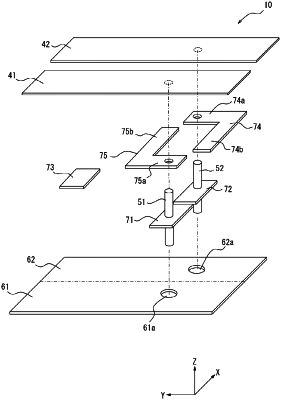| CPC H01Q 13/18 (2013.01) [H01Q 1/52 (2013.01); H01Q 21/06 (2013.01)] | 20 Claims |

|
1. An antenna comprising:
a first antenna element that includes a first radiation conductor and a first feeder line and is configured to resonate in a first frequency band;
a second antenna element that includes a second radiation conductor and a second feeder line and is configured to resonate in a second frequency band;
a first coupler; and
a first coupling portion, wherein
the second feeder line is configured to be coupled to the first feeder line by a first coupling in which a first component is dominant, the first component being a capacitance component or an inductance component,
the first coupler is configured to couple the first feeder line and the second feeder line by a second coupling in which a second component different from the first component is dominant, the second component being the inductance component or the capacitance component,
the first radiation conductor and the second radiation conductor are arranged at an interval equal to or less than ½ of a resonance wavelength of the antenna,
the second feeder line is configured to be coupled to the first radiation conductor by a third coupling in which a third component is dominant, the third component being the capacitance component or the inductance component, and
the first coupling portion is configured to couple the first radiation conductor and the second feeder line by a fourth coupling in which a fourth component different from the third component is dominant, the fourth component being the inductance component or the capacitance component.
|